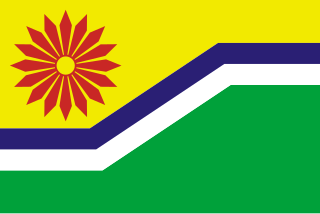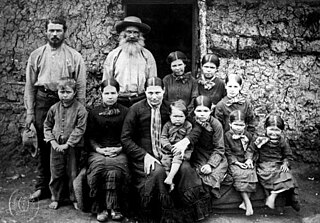
Boer is the Dutch and Afrikaans noun for "farmer". In South African contexts, "Boers" refers to the descendants of the then Dutch-speaking settlers of the eastern Cape frontier in Southern Africa during the 18th and much of the 19th century. From 1652 to 1795 the Dutch East India Company controlled this area, but the United Kingdom incorporated it into the British Empire in 1806.

The Second Boer War was fought between the British Empire and two Boer states, the South African Republic and the Orange Free State, over the Empire's influence in South Africa. It is also known variously as the Boer War, Anglo-Boer War, or South African War. Initial Boer attacks were successful, and although British reinforcements later reversed these, the war continued for years with Boer guerrilla warfare, until harsh British counter-measures brought them to terms.
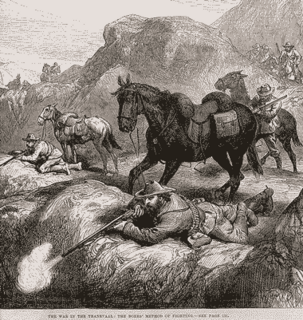
The First Boer War, also known as the First Anglo-Boer War, the Transvaal War or the Transvaal Rebellion, was a war fought from 16 December 1880 until 23 March 1881 between the United Kingdom and the South African Republic. The war resulted in defeat for the British and the second independence of the South African Republic.
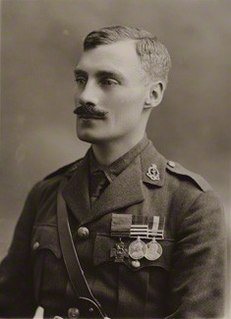
Lieutenant Colonel Arthur Martin-Leake, was a British physician, officer in the Royal Army Medical Corps and a double recipient of the Victoria Cross (VC), the highest award for gallantry in the face of the enemy that can be awarded to British and Commonwealth forces. Martin-Leake was the first of only three men to be awarded the VC twice, the others being Noel Godfrey Chavasse and Charles Upham.
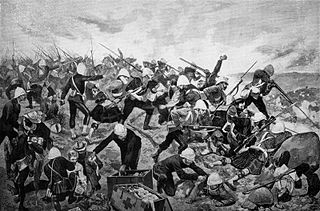
The Battle of Majuba Hill on 27 February 1881 was the final and decisive battle of the First Boer War. It was a resounding victory for the Boers and the battle is considered to have been one of the most humiliating defeats of British arms in history. Maj. Gen. Sir George Pomeroy Colley occupied the summit of the hill on the night of 26–27 February 1881. Colley's motive for occupying Majuba Hill may have been anxiety that the Boers would soon occupy it themselves, Colley having witnessed their trenches being dug in the direction of the hill. The Boers believed that he might have been attempting to outflank their positions at Laing's Nek. The hill was not considered to be scalable by the Boers, for military purposes, and hence it may have been Colley's attempt to emphasise British power and strike fear into the Boer camp.
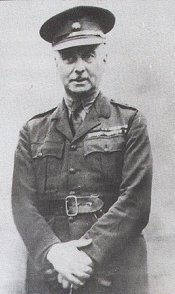
William John English VC was an Irish born recipient of the Victoria Cross, the highest and most prestigious award for gallantry in the face of the enemy that can be awarded to British and Commonwealth forces.

Reddersburg is a small town in the Free State province of South Africa.
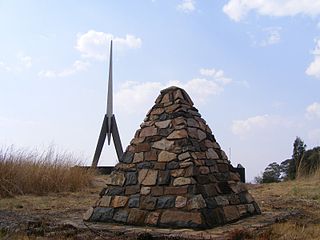
Belfast is a small town in Mpumalanga Province, South Africa. It is situated in the eMakhazeni Local Municipality in the Nkangala District Municipality.
The Maritz rebellion, also known as the Boer revolt or Five Shilling rebellion was an armed insurrection which occurred in South Africa in 1914 at the start of World War I, led by Boers who supported the reestablishment of the South African Republic in the Transvaal. Many members of the government were themselves former Boers who had fought with the Maritz rebels against the British in the Second Boer War, which had ended twelve years earlier. The rebellion failed, and the ringleaders received heavy fines and terms of imprisonment.

The Imperial Yeomanry was a volunteer mounted force of the British Army that mainly saw action during the Second Boer War. Created on 2 January 1900, the force was initially recruited from the middle classes and traditional yeomanry sources, but subsequent contingents were more significantly working class in their composition. The existing yeomanry regiments contributed only a small proportion of the total Imperial Yeomanry establishment. In Ireland 120 men were recruited in February 1900. It was officially disbanded in 1908, with individual Yeomanry regiments incorporated into the new Territorial Force.
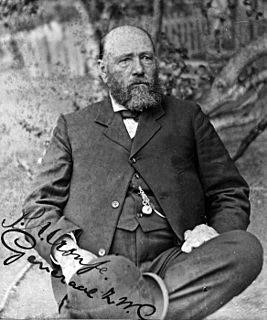
The Battle of Magersfontein was fought on 11 December 1899, at Magersfontein near Kimberley, South Africa, on the borders of the Cape Colony and the independent republic of the Orange Free State. British forces under Lieutenant General Lord Methuen were advancing north along the railway line from the Cape in order to relieve the Siege of Kimberley, but their path was blocked at Magersfontein by a Boer force that was entrenched in the surrounding hills. The British had already fought a series of battles with the Boers, most recently at Modder River, where the advance was temporarily halted.
Opposition to the Second Boer War (1899–1902) was a factor in the war. Inside Britain and the British Empire, there was strong opposition to the Boers and a minority in favour of them. Outside the situation was reversed and indeed condemnation of Britain was often intense from many sources, left, right and centre. Inside Britain influential groups, especially based in the opposition Liberal Party formed immediately. They fought ineffectually against the British war policies, which were supported by the Conservative Party of Prime Minister Salisbury.
The military history of South Africa chronicles a vast time period and complex events from the dawn of history until the present time. It covers civil wars and wars of aggression and of self-defence both within South Africa and against it. It includes the history of battles fought in the territories of modern South Africa in neighbouring territories, in both world wars and in modern international conflicts.

The Lint voor Verwonding is a South African military campaign award. It was instituted on 21 December 1920 as a retrospective award for Boer veteran officers and men of the 1899–1902 Second Boer War who had been wounded in action.

The Queen's South Africa Medal is a British campaign medal awarded to British and Colonial military personnel, and to civilians employed in an official capacity, who served in the Second Boer War in South Africa. Altogether twenty-six clasps were awarded, to indicate participation in particular actions and campaigns.

Ethnic, political and social tensions among European colonial powers, indigenous Africans, and English and Dutch settlers led to open conflict in a series of wars and revolts between 1879 and 1915 that would have lasting repercussions on the entire region of southern Africa. Pursuit of commercial empire as well as individual aspirations, especially after the discovery of diamonds (1867) and gold (1886), were key factors driving these developments.

Jan Christoffel Greyling Kemp was a South African Boer officer, rebel general, and politician.

The military history of Australia during the Boer War is complex, and includes a period of history in which the six formerly autonomous British Australian colonies federated to become the Commonwealth of Australia. At the outbreak of the Second Boer War, each of these separate colonies maintained their own, independent military forces, but by the cessation of hostilities, these six armies had come under a centralised command to form the Australian Army.
Major-General Sir Edward Nicholson Broadbent, was a British Army officer who became Lieutenant Governor of Guernsey.

Krugersdorp Commando or Kommando was a light infantry regiment of the South African Army. It was active as a part of the South African Army Infantry Formation as well as the South African Territorial Reserve.
